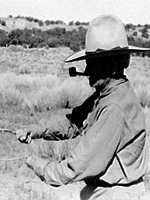
Riddle, Isabella E.AboutBrief biographical sketch of Mrs. Riddle, born of Irish immigrant parents, she was one of first 100 women appointed to the WAVES during World War II. She moved with her husband to Las Cruces in 1947. Talks briefly of conditions in Las Cruces upon her arrival. Interview focuses on her knowledge of Dr. Stephen's work in developing a heritage institute during the time they worked together at the Department of Agriculture from 1972 (when Dr. Stephens was appointed director) until her retirement in 1981.
Abstract
Tape 1, Side A
Isabella E. Riddle was interviewed concerning her knowledge of the founding of the New Mexico Farm & Ranch Heritage Museum. Riddle was employed by the Department of Agriculture, State of New Mexico from 1961-1981. She started her career as secretary to the director, Dallas Reyerson, the first director of the department. Reyerson, who died in 1971, was followed in the directorship by Dr. Bill Stephens in 1972. When the consultant retired in 1981 she was Assistant Director. Riddle was born in 1917 in Philadelphia. Her parents were immigrants. Her father came to the United States from Ireland at age 15, and her mother immigrated at age 13, following the death of her mother. Discusses briefly her parents' early years in the United States. Her parents married in 1916, she was the oldest child and had two younger brothers. Riddle attended grammar and high school in Philadelphia, graduating in 1936. She was awarded a scholarship to college which she was not allowed to take due to the economic conditions. She went to work at minimum wage, $15.00 a week. She worked in this position for seven years until 1941, when she entered the "women's organization" of the Navy, the WAVES (one of the first 100 women to be accepted). The positions open to women: yeoman (secretary), supply clerk, or radio operator. Riddle was trained for six months at the University of Wisconsin as a radio operator. She was stationed in Washington, D.C. until April 1946. She married a marine, who had been severely wounded in the war. They came to New Mexico in 1946 seeking a better climate for his health. Her husband found work at Prices' Creamery, then located on Alameda Street in Las Cruces. Discusses briefly life in Las Cruces upon their arrival in 1947. She went to work for Pat Campbell's Insurance, and later for the builder, Seaborn Collins, who built the first houses in Las Cruces that were FHA and GI loan eligible.
Tape 1, Side B
In 1961 she went to work for the Department of Agriculture. Discussion of how she first became aware of Dr. Stephen's interest in establishing a heritage institute. She recalls that Dr. Stephens was initially interested in attempting to get ranch records archived, and that he was often disappointed when ranchers would not allow their records to be preserved. She states that very early in the plans for a heritage institute, there was an idea of placing a building for the institute on a strip of land on the south side of University Avenue, immediately east of I-10 (across from the Holiday Inn). In the time period before she left the Department of Agriculture in 1981, Dr. Stephens concentrated on meeting farmers and ranchers one on one. He did not approach them for funds, but discussed the project and talked to them about preserving their business records and old equipment. Mrs. Riddle stated that Dr. Stephens worked seven days a week, 18 hours a day. He also expected his staff to work long hours if they were working on a project. She believes that his willingness to "go the extra mile" contributed to the Museum's development.
Tape 2, Side A
Consultant states that Dr. Stephens had the ability to articulate the "needs of the ranchers and farmers." Discusses that she did not know what Dr. Stephen's opinion was of the heritage institute being place under the auspice o the Office of Cultural Affairs, but states that the "Department of Agriculture did not have the expertise" to manage a museum or exhibit program. She believes that Governor King was instrumental in helping the states' agriculturists accept that the Museum would need state support. Riddle states that Dr. Stephens was "conscientious" of not involving the staff at the Department of Agriculture in working on the heritage institute project. "He did it himself." She states that Lana Dickson is the exception to the rule. |

